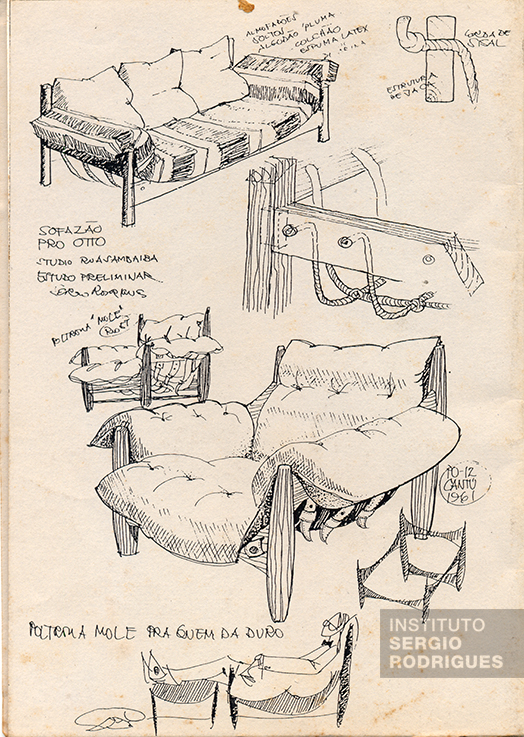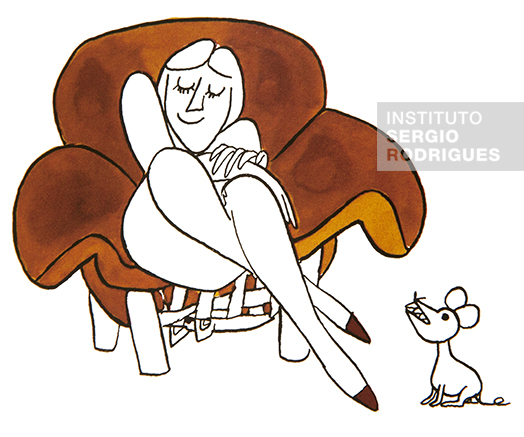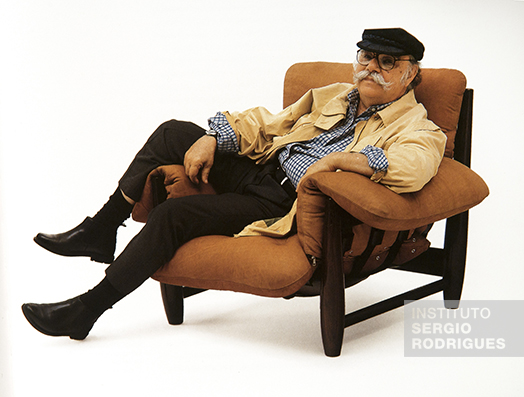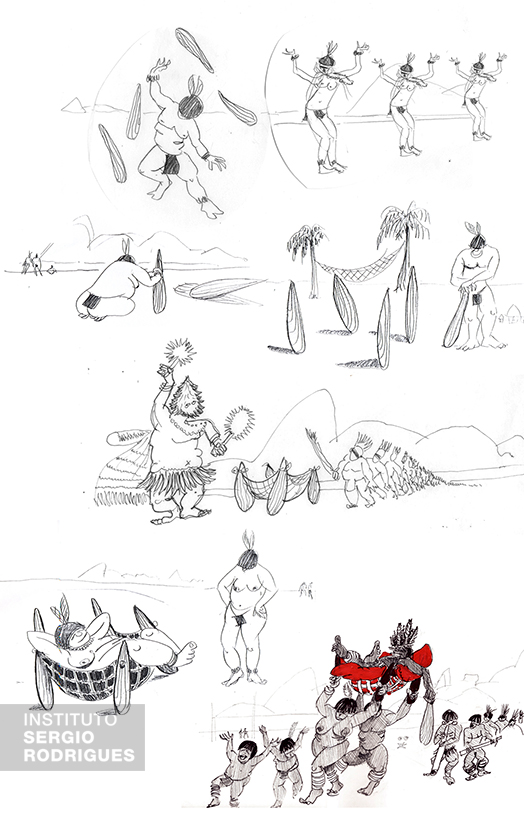"A wonderful synthesis of the Brazilian spirit." (Odilo Ribeiro Coutinho)
“A wonderful synthesis of the Brazilian spirit.” (Odilo Ribeiro Coutinho)
In 1962, when he decided to hold the “Furniture as an Object of Art” exhibition at Oca, Sergio made a chair that he had been designing for over a year and was named Mole. He said the piece was not well received at the time. With his usual humor, he described the general reaction: “If my drawings were considered ‘futuristic,’ well then that one could not be qualified at all. A piece of leather on those pieces of wood was just too much. Onlookers standing at the display window would say that is was very expensive to be a dog bed.” Others called it a fried egg.
Mole came up against a bitter, discouraging lack of interest in it and was forgotten for a year in Oca’s display window. “Instead of beating me up, my partners wanted to keep the chair in the back of the shop, but I decided to face them on that issue because I had a lot of faith in the chair. And it started being accepted by people of a certain cultural level.” Until it called the attention of several personalities, including the then Governor Carlos Lacerda, who practically demanded that Sergio send the chair to a competition in Italy. Sergio obeyed, but without much conviction. He even tried to reason with the governor.
“It was a joke to me. I said to him: ‘Look, I will not submit this to an international competition. People in Europe are doing work at a very high level, it is not worth it, I only have this piece of wood.’ But he insisted, and we sent the drawings in.”
A week later contest organizers advised us that Mole could not compete because it was already known. “To me, in and of itself, that was already a diploma, since I was not aware of the fact that the chair was already known in Europe.” Sergio then made a small change to the chair, entered it in the competition and it was accepted.
Mole ended up taking first place in the 4th International Furniture Competition, in Cantu, Italy, in 1961. The European press highlighted, in various publications, the casual atmosphere generated by the loose cushions thrown on the Sheriff Chair structure, as it became known abroad. The award put Brazil in a prominent position in design on the world stage. The Sheriff name was given by the licensed manufacturer in Italy, which went on to produce the chair.
Sergio believes that one of the reasons why the chair was awarded was because it was considered one of the first postmodern pieces of furniture. “There was a Brazilianness accent. It was a piece that easily revealed where it had been made. It could only have come from a place where there was a lot of wood and leather. And there was a certain informality in the design,” said Sergio to the Folha de S. Paulo newspaper, in February 2006.
With robust, sexy wooden components that were a pleasure to touch, and made in the traditional construction techniques, with bolts, generous cushions, leather straps forming a basket where the cushions, also made of leather, would be put, the roundish wooden frame: that is how the Mole armchair came into being, enabling the user to shape his or her body anatomically to sit comfortably. This description does not only define a piece of furniture, rather a key project in Brazilian design.
The idea of the Mole armchair came from one of Sergio Rodrigues’ desires to create furniture that expressed the national identity. The embryo of the Mole appeared in 1957 to meet a request from the photographer Otto Stupakoff, who asked for a sofa for the tiny studio he would put together in Rio. Sergio himself says how the order was made: “Sergio, come up with a sprawling sofa, as if it were a Sultan’s, to put in the corner of my studio.” According to Sergio, the sofa would be a piece for resting. “The idea was for it to be there for the person to feel at ease. But he really could not buy it because it was a very expensive piece, handmade out of Jacaranda. He ended up paying for the piece by photographing it for Oca’s first catalog.”
Mole’s successful career began in Cantu, but unfolded in Oca. Although it was not well received at first, a year after its launch the store started getting several orders for the chair, which secured its place on the market. It was not the bestselling piece of the store, but it had distinguishable qualities.
Mole would soon become an icon, perhaps the piece of Brazilian design that was best known individually. The sociologist Odilon Ribeiro Coutinho says that Mole was the first “irreducible” Brazilian object of art that did not imitate the colonizer. “It is wonderful synthesis of the Brazilian spirit.”
Maria Cecilia Loschiavo dos Santos, a philosopher and historian of Brazilian design, wrote: “The craving to design a piece of furniture to express the national identity took Sergio Rodrigues to a design that mocked the reigning standards: To the slender and elegant stick feet, Mole replied with the thickness and the strength of the Brazilian Jacaranda. In and of itself, this was already a great revolution. One aspect that stood out strongly in this project was the designer’s attempt to respond to new sitting habits that emerged at the time, mainly some very peculiar informal behavior among Rio de Janeiro natives, which Sergio so ably captured and expressed in his furniture.”
In this sense, Sergio anticipated the so-called aesthetics of thickness, which, subsequently, formed the foundation of some of the forefront movements he engaged in during the 1960s. From there, the “muié dama,” as anthropologist Darcy Ribeiro called it (“it embraces you, envelops you, you like getting tangled in it”), began to gain notoriety. Another who loved the chair was Millôr Fernandes: “That’s when Sergio Rodrigues’ aesthetic talent came to meet my good sense and comfort requirements and, unexpectedly, pushed the aforementioned Mole chair beneath me. I did not sit on it. I laid down and rolled around on it,” wrote Millôr. To him, Mole is the furniture version of Sharon Stone.
It was the workers who made the chair themselves that gave it its name. It comes from the Portuguese word soft, limp. Six years after winning in Cantu, Sergio made another change to Mole and created Moleca, without changes to cushion design. It was the Mole-Ex or Mole for export.
The creator explained the versions of his creature in the 2006 Folha interview: “There are three Mole armchair models. The first was created in 1957, and had a more rigid structure. The second version was sent to Italy in 1961. Then came the Moleca version. Since it was not possible to create an armchair from one day to the next, Sergio took Mole itself and made a few changes. It remained with the same feet, structure, and he made some curves on what had been flat and straight. A month later came the Italian award and immediately thereafter an invitation from the Isa outfit, from Bergamo, for series production. The plant called Mole Sheriff. The third Mole was then called Moleca. It can be disassembled to reduce the packaging and shipping cost in exports, with certain colonial touches of wood and assembly with wedges.”
Art critic Afonso Luz considers Mole a landmark. “I think that until the Mole armchair he is faced with a challenge of Brazilian modernity, the challenge of establishing his autonomy in terms of language, technology, and local structural solutions toward the world. After that, Sergio Rodrigues got more freedom, this great humor and the style of a sophisticated informality that create a strong authorial reference, something all of his own.”
Today, Mole is part of the collection of the Museum of Modern Art (MoMA) in New York, and has become a big sales hit.

Illustration by Sergio Rodrigues for the "Speaking about Chairs, 1954/1991 retrospective" exhibition held at the Rio de Janeiro Museum of Modern Art from December 17, 1991, to January 21, 1992.

Millôr Fernandes' drawing of the Mole armchair by for the Oca catalog, 1965.

Sergio Rodrigues on the "Mole" Armchair, in the 1990s.

Drawing by Sergio Rodrigues illustrating the creation of the Mole armchair.
